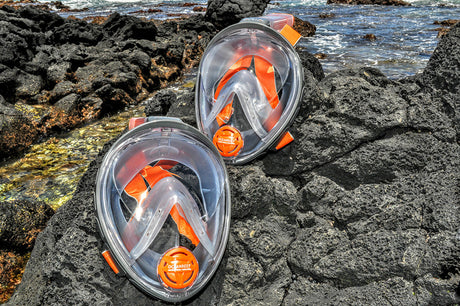What’s the Difference and Which One is Right for You?
Exposure protection is essential in scuba diving. Whether you're diving in warm tropical waters or icy depths, maintaining body heat is crucial for safety and comfort. The two primary types of thermal protection suits, wetsuits and drysuits, serve distinct purposes based on dive conditions. Choosing the right one depends on where and how you dive, your body’s response to cold, and how long you'll be underwater. Let’s break down the key differences between a wetsuit and a drysuit to help you make the right choice for your next dive.
How Wetsuits Work
Wetsuits are made from closed-cell neoprene designed to trap a thin layer of water between the suit and your skin. Your body warms this water, creating an insulating layer that slows down heat loss. These suits are meant to fit snugly. If they're too loose, cold water will flush in and out, reducing insulation. Wetsuits come in varying thicknesses. Thinner suits, such as 1mm to 3mm, are ideal for warm water temperatures of 75°F and above, while thicker suits ranging from 5mm to 7mm are needed for cooler environments. Wetsuits also offer protection against sun exposure, stings, and abrasions.
When to Use a Wetsuit
Wetsuits are best for dives in water temperatures between 50°F and 89°F. Here's a basic guide to wetsuit thickness by temperature:
- 82–89°F: Dive skin or 1mm shorty
- 75–84°F: 3mm full suit
- 65–75°F: 5mm full suit
- 50–65°F: 7mm full suit
In addition to thermal protection, wetsuits offer defense from jellyfish, reef scrapes, and harmful UV rays, making them practical for recreational dives in most moderate to warm water conditions.
How Drysuits Work
Drysuits are designed to keep you completely dry. They seal out water using wrist and neck gaskets and a waterproof zipper. These suits are constructed from materials like trilaminate, crushed neoprene, or vulcanized rubber. Unlike wetsuits, drysuits trap a layer of air around your body. You can wear thermal undergarments underneath to enhance warmth. You control the air inside the suit using inflator and exhaust valves, which also assist with buoyancy control. Drysuits require training to use properly, especially for buoyancy, but they provide exceptional insulation and are preferred by cold-water and technical divers.
When to Use a Drysuit
Drysuits are ideal for water temperatures below 50°F or for dives with extended bottom times where thermal protection is critical. Many technical divers use drysuits even in warmer waters because of the depth and duration of their dives. Since the body loses heat much faster in water than in air, staying dry and surrounded by an insulating air layer offers more effective and long-lasting warmth than a wetsuit can provide.
Side-by-Side Comparison: Wetsuits vs Drysuits
| Feature | Wetsuit | Drysuit |
|---|---|---|
| Material | Closed-cell neoprene | Neoprene, trilaminate, rubber, or nylon |
| Fit | Skin-tight | Loose fit with underlayers |
| Thermal Protection | Traps water warmed by body heat | Traps air and uses thermal undergarments |
| Water Entry | Allows water in then insulates | Fully sealed with no water entry |
| Buoyancy Control | Simple | Requires training and skill |
| Ideal Conditions | 50 to 89°F waters | Below 50°F or long-duration dives |
| Maintenance | Minimal | Higher maintenance and care required |
| Lifespan | Moderate, about 3 to 7 years with care | Long-term, 10 to 15+ years with proper care |
Wetsuit Pros and Cons
Pros:
- Lightweight and easier to travel with
- More affordable with various styles and thicknesses
- Versatile use for surfing, snorkeling, and swimming
Cons:
- Less effective insulation in colder waters
- Takes time to dry
- Limited bottom time in cold environments
Drysuit Pros and Cons
Pros:
- Keeps you dry and warmer for longer durations
- Ideal for cold and extreme dive conditions
- Allows layering for additional insulation
- Excellent for technical and deep diving
Cons:
- Higher upfront cost
- Requires specific training
- Bulkier and less convenient for travel
Which Exposure Suit Is Right for You?
Choosing between a wetsuit and a drysuit comes down to dive conditions and personal preference. For tropical or moderate waters, a wetsuit is typically sufficient and more budget-friendly. For cold water, long dives, or technical diving, a drysuit is the better investment. No matter which you choose, always prioritize comfort, safety, and the right level of thermal protection for your dive environment.









